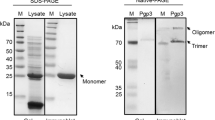Summary
The researches on chlamydia in recent years show that chlamydia bacteriophage may be a potential and effective means to solve the clinical infection of chlamydia trachomatis (Ct). We investigated the biological effect of chlamydiaphage phiCPG1 capsid protein Vp1 on Ct both in McCoy cells and genital tract of mice. Different concentrations of Vp1 were co-incubated with Ct E serotype strain in McCoy cells. Female BALB/c mice were used to establish Ct E strain-induced urogenital infection model. They were randomly divided into five groups and given different treatments on the fifth day after Ct inoculation. Animals in groups 1 and 2 were given 30 μL different concentrations of Vp1 in the genital tract respectively, those in group 3 were intramuscularly injected with 30 μL Vp1, those in the infected group did not receive any intervention, and those in the control group received 30 μL PBS in the genital tract. The vaginal discharge was collected to identify the live chlamydia by cell culture and gene fragment by real time PCR different days after infection. Inhibition rate of 100 μg/mL and 50 μg/mL Vp1 proteins against Ct E strain in the McCoy cell cultures was 91% and 79% respectively. The number of intracellular Ct inclusion in the McCoy cells co-cultured with vaginal discharge of group 1 and group 2 was less than in the infected group, and that in group 1 was less than in group 2, on the 7th day after Ct inoculation. Real-time PCR showed that chlamydia concentration of the vaginal discharge in group 2 was lower than in the infected group, and that in group 1 was lower than in group 2 on the 10th day. It was suggested that Vp1 capsid proteins had inhibitory effect on the proliferation of Ct serovar E strain in cell culture and mouse genital tract.
Similar content being viewed by others
References
Liu YJ, Sheng CH, Liu Y, et al. Preparation, identification and application of polyclonal antibody against major outer membrane protein of Chlamydia trachomatis E. Chin J Infect Dis (Chinese), 2011,29(5): 257–260
Kong FYS, Hocking JS. Treatment challenges for urogenital and anorectal Chlamydia trachomatis. BMC Infect Dis, 2015,15(1): 1–7
Hou SP, Liu YJ, Ma JY, et al. Preparation and preliminary application of monoclonal antibody against Vp1 protein of chlamydiaphage FCPG1. Chin J Dermat (Chinese), 2010,43(5): 320–323
Ma JY, Liu QZ, Liu YJ, et al. Detection of Chlamydia trachomatis phage capsid protein Vp1 antibody. Chin J Dermat (Chinese), 2009,42(5): 360–362
Hsia RC, Ohayon H, Gounon P, et al. Phage infection of the obligate intracellular bacterium, chlamydia psittaci strain guinea pig inclusion conjunctivitis. Microbes Infect, 2000,2(7): 761–772
Illya T, Christelle EH, Carabeo RA. Human guanylate binding proteins potentiate the anti-chlamydia effects of interferon-gamma. Plos One, 2012,4(8):e6499–e6499
Liu YJ, Hou SP, Wei JR, et al. The effect of chlamydiaphage phiCPG1 capsid protein Vp1 on the Chlamydia trachomatis. Chin J Microbiol Immunol (Chinese), 2012,32(5): 403–407
Sandoz KM. Antibiotic resistance in Chlamydiae. Future Microbiol, 2010,5(9): 1427–1442
Zeng H, Gong SQ, Hou SP, et al. Identification of antigen-specific antibody responses associated with upper genital tract pathology in mice infected with Chlamydia muridarum. Infect Immun, 2011,80(3): 1098–1106
Salim O, Skilton RJ, Lambden PR, et al. Behind the chlamydial cloak: the replication cycle of chlamydiaphage Chp2, revealed. Virology, 2008,377(377): 440–445
Read TD, Brunham RC, Shen C, et al. Genome sequences of Chlamydia trachomatis MoPn and Chlamydia pneumoniae AR39. Nucleic Acids Res, 2000,28(6): 1397–1406
Everson JS, Garner SA, Lambden PR, et al. Host range of chlamydiaphages phiCPAR39 and Chp3. J Bacteriol, 2003,185(21): 6490–6492
Laszlo K, Whitmire WM, Carlson JH, et al. Pathogenic diversity among Chlamydia trachomatis ocular strains in nonhuman primates is affected by subtle genomic variations. J Infect Dis, 2008,197(3): 449–456
Meijer A, Morré SA, Brule AJ, et al. Genomic relatedness of Chlamydia isolates determined by amplified fragment length polymorphism analysis. J Bacteriol, 1999,181(15): 4469–4475
Morré SA, Lyons JM, Ito JI. Murine models of Chlamydia trachomatis genital tract infection: use of mouse pneumonitis strain versus human strains. Infect Immun, 2000,68(12): 7209–7211
Yang B, Zheng HP, Feng ZQ, et al. The prevalence and distribution of Chlamydia trachomatis genotypes among sexually transmitted disease clinic patients in Guangzhou, China, 2005-2008. Jpn J Infect Dis, 2010,63(5): 342–345
Author information
Authors and Affiliations
Corresponding author
Additional information
This project was supported by National Natural Science Foundation of China (No. 31370211).
Rights and permissions
About this article
Cite this article
Wang, S., Guo, R., Guo, Yl. et al. Biological effects of chlamydiaphage phiCPG1 capsid protein Vp1 on chlamydia trachomatis in vitro and in vivo . J. Huazhong Univ. Sci. Technol. [Med. Sci.] 37, 115–121 (2017). https://doi.org/10.1007/s11596-017-1704-1
Received:
Revised:
Published:
Issue Date:
DOI: https://doi.org/10.1007/s11596-017-1704-1




